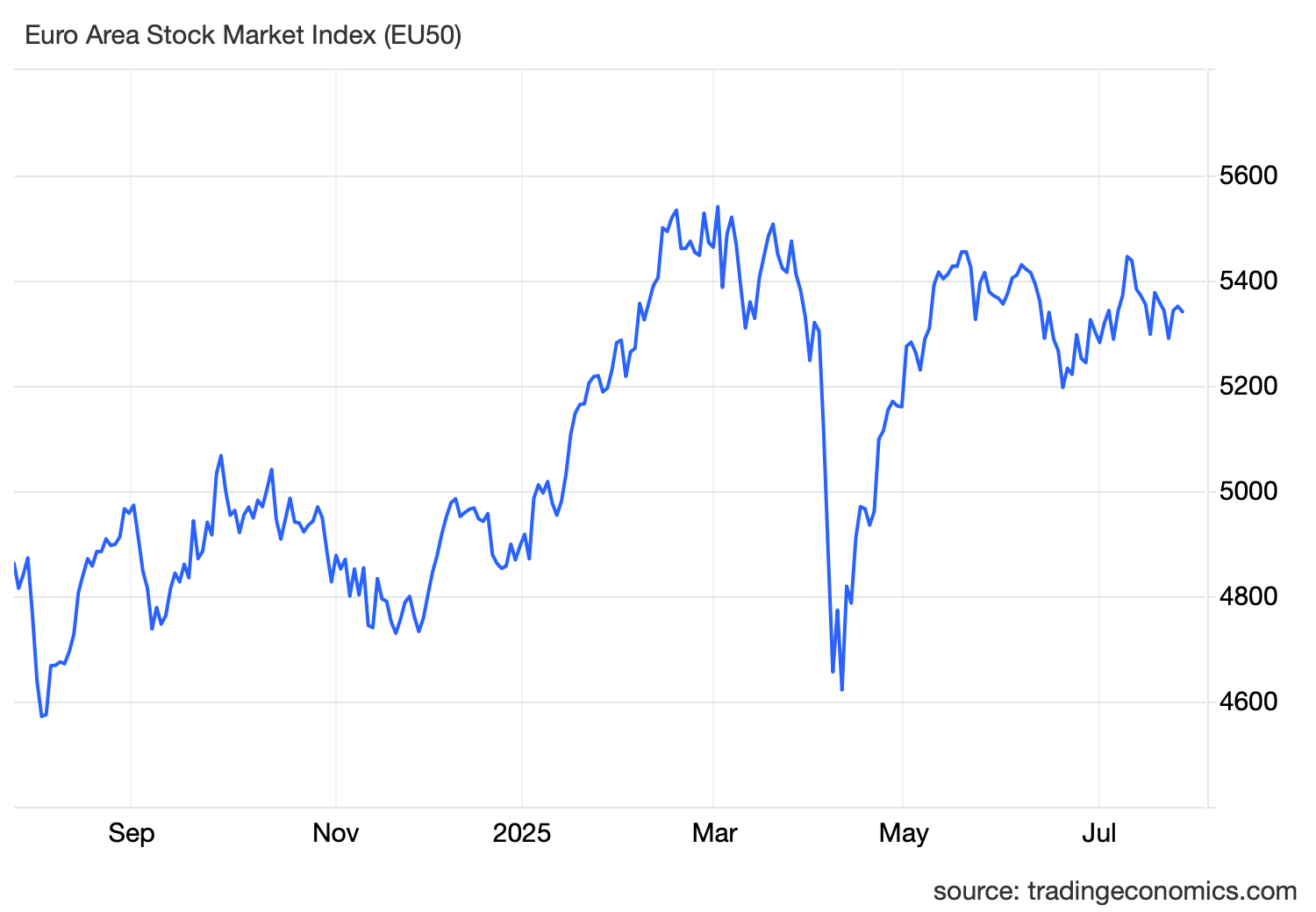European Markets Fall as Earnings Disappoint ad Trade Uncertainty Weighs on Sentiment
European Markets Slide as Earnings Miss and Trade Concerns Pressure Sentiment
European equities closed lower on Friday, with both the STOXX 50 and STOXX 600 declining by 0.5%, as all major sectors and regional bourses registered losses. The selloff was triggered by a series of disappointing corporate earnings, renewed anxiety around US–EU trade negotiations, and a stronger euro that continues to weigh on European exporters.
The auto sector was one of the hardest hit, reflecting a broader unease over the potential for new tariffs from the United States. Shares of Volkswagen dropped over 2% after the company slashed its full-year outlook, citing tariff-related pressures and weakening sales momentum, particularly in China. French tire manufacturer Michelin also fell more than 1% after posting a 27.8% decline in net income for the first half of 2025, which the company attributed to currency headwinds and weakening demand in core European markets. Meanwhile, Valeo—a major auto parts supplier—suffered a staggering 13.4% plunge after revising down its sales guidance due to the impact of the euro’s appreciation, which has recently reached a six-month high on the ECB’s trade-weighted index.
Luxury and consumer discretionary stocks also faced significant losses. LVMH slipped 1.5% after posting quarterly sales that fell short of market expectations. Analysts pointed to softer consumer demand across Europe and China, as well as a more cautious outlook for luxury spending heading into the second half of the year. In the energy sector, Eni posted a 25% drop in quarterly profits, largely due to weaker refining margins and stagnant crude prices, leading to a modest decline of 0.3% in its share price.
However, the largest single-day decline among blue chips came from Puma, whose shares plummeted by 19%. The German sportswear brand issued a stark profit warning, forecasting a full-year loss due to a combination of weaker global sales and mounting cost pressures stemming from US tariffs. The company emphasized that higher input costs, shifting consumer demand in the US, and prolonged exposure to supply chain friction have eroded its margins more severely than expected.
Friday’s retreat wiped out gains from earlier in the week. While the STOXX 50—comprising Europe’s largest firms—ended the week down by 0.2%, the broader STOXX 600 still managed to register a 0.8% weekly gain. This divergence reflects earlier resilience from defensive sectors such as utilities, healthcare, and financials, which helped lift the broader index before Friday’s downturn.
Underlying many of the earnings downgrades is the strengthening euro, which has risen by more than 2% against the US dollar over the past month. This currency appreciation adds pressure to eurozone exporters, whose dollar-denominated revenues are now worth less in euro terms. According to the European Central Bank’s latest data, the euro’s trade-weighted value has reached its highest point since January, raising competitiveness concerns for key industrial exporters in Germany and France. Companies with weak hedging policies are particularly vulnerable, as evidenced by Valeo’s profit warning and Michelin’s earnings miss.
Compounding the pressure on investor sentiment is the lack of clarity in ongoing US–EU trade negotiations. Tensions resurfaced this week after renewed threats from the US to impose tariffs on European auto and luxury goods, which could impact as much as $50 billion in bilateral trade. The European Commission has yet to signal whether any substantial progress has been made in de-escalating these trade threats. Investors, already fatigued by geopolitical unpredictability, have begun pricing in a higher risk premium for firms with heavy US exposure.
Analysts now anticipate a downward revision in earnings per share (EPS) growth forecasts for Europe’s auto sector in Q3 2025. Bloomberg consensus data shows EPS expectations have been cut from a positive 2.1% to a negative 3.6%, driven largely by cost shocks and deteriorating export competitiveness. Similarly, luxury sector earnings forecasts have been revised downward from 8.5% to 5.2% growth for the next quarter.
In contrast, US equity markets have remained more stable, buoyed by stronger-than-expected earnings from the technology sector and domestic consumer resilience. The S&P 500 posted a mild weekly gain of 0.1%, offering a stark contrast to Europe’s struggles. The divergence reflects not only regional earnings dynamics but also relative insulation from global currency movements and more stable domestic demand conditions in the United States.
The outlook for European equities remains fragile. With the ECB maintaining an accommodative policy stance while other global central banks edge toward tightening, euro strength may persist—further challenging export-focused firms. Meanwhile, if trade negotiations between Brussels and Washington deteriorate further, sectors such as autos, luxury, and manufacturing could see intensified volatility in both pricing and outlooks.
Friday’s market movement highlights the risks facing Europe’s equity markets in the second half of 2025: a convergence of softening demand, currency pressures, tariff threats, and downgraded earnings guidance. As companies revise their forward guidance, and as trade talks remain unresolved, investor caution is likely to persist, particularly for firms with high exposure to non-EU markets.
References
Bloomberg L.P. (2025) Earnings Tracker – Europe Q3 Forecasts. Bloomberg Terminal.
Reuters. (2025) “Puma issues profit warning as US tariffs bite.” Reuters Business News, 25 July.
Volkswagen AG. (2025) Investor Relations – July 2025 Earnings Call. www.volkswagen-group.com
European Central Bank. (2025) Euro Effective Exchange Rate Index – July Update. www.ecb.europa.eu
European Commission. (2025) DG Trade Brief – Transatlantic Tariff Policy Outlook. Brussels.
